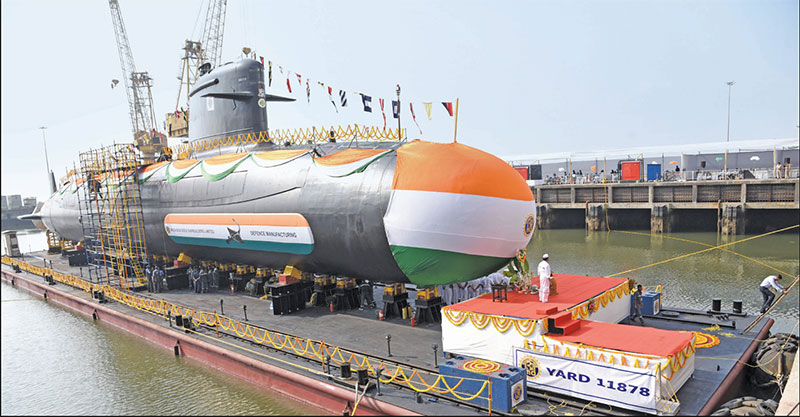India is woefully behind China in indigenously produced submarines
Rohan Ramesh | Bengaluru
In the near future, the Indian Ocean on either side of the Indian peninsula and to the south of Sri Lanka is likely to be the most active playground of navies. And the most important naval power, with reference to India’s strategic interests, will be China. With China becoming a world power, and the tensions born out of the trade war between the US and China increasing, China is set to strengthen its naval forces.

China, whose strategic thinking has been historically focused on land forces, is now focusing on its navy as a tool of force projection and also to protect its trade interests, particularly its energy supply routes from West Asia.
Given its close defence relationship with Pakistan, China’s naval ambitions in the Indian Ocean Region (IOR) are of concern to India, more so the Chinese submarine fleet, which can pose a serious threat to the Indian Navy flotillas.
Seven years ago, at the 18th Congress of Chinese Communist Party (CPC), President Xi Jinping laid down the roadmap for China’s development as a naval power.
“China is at once a continental power and a maritime power (haiyang daguo) and it possesses broad maritime strategic interests… These achievements have laid a solid foundation for building a strong maritime power (haiyang qiangguo),” said President Xi.
The Chinese news agency, Xinhua, reported on 31 July 2013, ‘Xi Jinping stresses the need to show greater care about the ocean, understand more about the ocean and make strategic plans for the use of the ocean, push forward the building of a maritime power and continuously make new achievements at the Eighth Collective Study Session of the CPC Central Committee Political Bureau.’
No wonder that the Chinese Navy is feverishly beefing up, both its surface fleet as well as the numbers of its submersible vessels. Given the potential for conflict in the region, its submarine fleet is of great interest, considering not just the numbers, but also increasing sophistication and lethality.
Taking the present numbers of the submersible vessels and considering those under construction, the Chinese submarine strength by mid-2020 is likely to be around 58 vessels, compared to India’s 15.
These will include four Jin class (Type-094) SSBNs and six SSNs/SSGNs - two Shang I class (Type-093) and four Shang II class (Type-093A). Add 48 diesel-electric submarines - Four Ming class (Type-035), 12 Song class (Type-039), 12 Kilo class (Project 877/Project 636/Project 636M) and 20 Yuan class (Type-039A/B) - and that is the picture of a formidable navy which is able to protect Chinese interests both close to the mainland, and to project power beyond.
But, for India, the challenge is two-fold, considering the China-Pakistan axis that it has to face. Admittedly, the Pakistan Navy is much smaller than the Indian Navy. But what matters is the intention and not the size in a conflict scenario. Pakistan has three Agosta 90B Class diesel-electric submarines armed with guided missiles, and two Agosta 70 Class Attack Submarines. Pakistan is reported to have signed an agreement with Chinese Shipbuilding Industry Corporation for eight attack submarines with four of the subs being built in China, and four in the state-owned shipyard in Karachi. The deal is estimated to be worth USD4-5 billion.
More importantly, Pakistan is reportedly upgrading the subs feverishly, and is believed to have signed a deal with Turkish firm STM for modernising its Agosta 90Bs. Pakistan is also reported to be planning a submarine with nuclear propulsion, with the vessel to be ready by 2025.
Given the scenario, the Indian Navy has a challenge on its hands – to modernise its submarine fleet as well as to acquire/build more to deal with a possible twin-threat from China and Pakistan, and protect its coasts, energy supply lanes, off shore territories and ocean resources.
Does it have the wherewithal to meet its tasks? Let’s take a look at India’s submarine fleet.
The current submarine fleet of the Indian Navy has four Shishumar class submarines procured from Germany in the Eighties and the Nineties. The four submarines in service are INS Shishumar (S44), INS Shankush (S45), INS Shalki (S46), INS Shankul (S47). These Type 209 submarines were designed by the German shipyard Howaldtswerke-Deutsche Werft (HDW) for the Indian Navy.
The Shishumar class submarines are basically diesel-electric powered and are classified as attack submarines. These submarines displace 1,850 t (1,821 long tonnes) submerged. Each of these Shishumar class submarines are powered by four MTU 12V 493 AZ80 GA31L diesel-electric motors generating 2,400 hp (1,790 kW) each. They also have one Siemens motor making 4,600 hp (3,430 kW) and four 1.8 MW Siemens alternators.
The submarines are fitted with Atlas Elektronik CSU 83 sonar, a Thomson Sintra DUUX-5 passive sonar and also a Thomson-CSF Calypso surface search radar. The armament includes 14 AEG-SUT Mod-1 torpedoes, 24 external strap-on mines and UGM-84L Harpoon Block II missiles.
You must be logged in to view this content.

